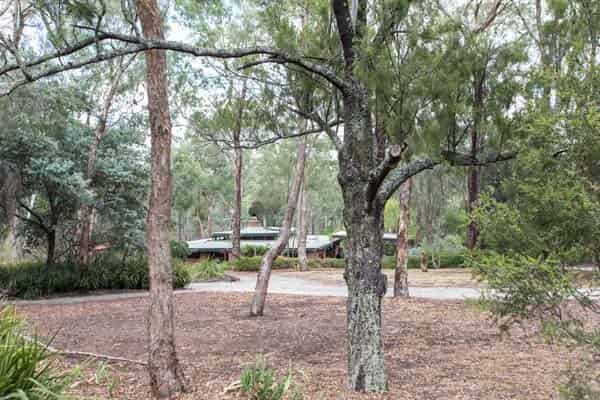Alistair Knox (1912-1986): modernism, environment and the spirit of place, Alistair Knox (1912-1986): modernism, environment and the spirit of place
Alistair Knox (1912-1986): modernism, environment and the spirit of place
Author: Richard Peterson & Bohdan Kuzyk
Alistair Knox is one of a small number of architects and building designers in Victoria who are recognised by the general public as identities and whose architecture gave rise to a regional style.
 Sample house for Dome Constructions, Donvale. circa 1958
Sample house for Dome Constructions, Donvale. circa 1958
He created a very large body of work; approximately 1,260 documented buildings, including suburban estates, halls, colleges, landscapes and hundreds of houses of which three were for himself and his family 1. Such was his success and influence that in 1983 the Australian Institute of Landscape Architects appointed Knox a Fellow and the following year the University of Melbourne conferred on him an Honorary Doctorate. Yet no Knox building is on the Victorian Heritage Register, though some are in local planning scheme heritage overlays. 2
 Photo: Lynne Cooke
Photo: Lynne Cooke
Many contemporaries saw Knox as amateur philosopher, adventurer, entrepreneur, storyteller and raconteur; but he is especially known as a designer, builder, writer, lecturer, local politician/activist, and promoter of adobe construction sited within the natural environment. As Bruce Mackenzie noted, a Knox house ?grew in the landscape in the way that trees adapted? to inevitable forces?. 3 Knox himself wrote that ?earth wall construction stimulates a point of view and a relationship with nature that no other material is able to do. It makes everything seem possible by retaining much of the wonder and mystery that is the power of the natural environment?. 4
While Knox presented different aspects of himself to different people and few seem to have seen the whole person, as our work proceeded, we saw a larger presence emerge, one that could stand alongside the great Victorian modernists Robin Boyd, Peter McIntyre and Kevin Borland. This is expressed in Knox?s distinctive Romantic world-view, his perception of the Australian landscape, of modernity, of his place in a historical continuum and in his relation to artists. It is also expressed in his developing a recognisably regional ?Eltham Style? of architecture and landscape practice, as a writer of some eloquence and breadth, and activist and municipal politician.
Youth
Alistair Samuel Knox was born in a Federation style house on a five-metre frontage, in Ashworth Street, Middle Park. As a boy he noticed that the road system in this part of the municipality comprised as much as sixty percent of the total land space! ... this liberality of street space kept the generally small pieces of land the individual houses occupied from conveying any sense of meanness or poverty. Instead, a relaxed, natural spaciousness - something the twentieth-century suburb has lacked - was created. 5
From a dedicated evangelical Free Presbyterian family, 6 Knox felt that the Sunday Meetings gave him ?a sense of identity in a clearly identifiable community. Every member had an equally significant part to play?. 7 As a boy, he had access to his Uncle Jim?s magnificent tool collection, with a carpenter?s bench handed on from Uncle Jim?s father, George Forman. This made a deep impression: George had been a joiner, and his tools were branded with his name countersunk into them. His beech wood jack-plane was a sermon of constancy. The grip of his left hand had worn its shape into the front of the plane, and his right hand fit perfectly on the handle he had used every working day for forty years. 8
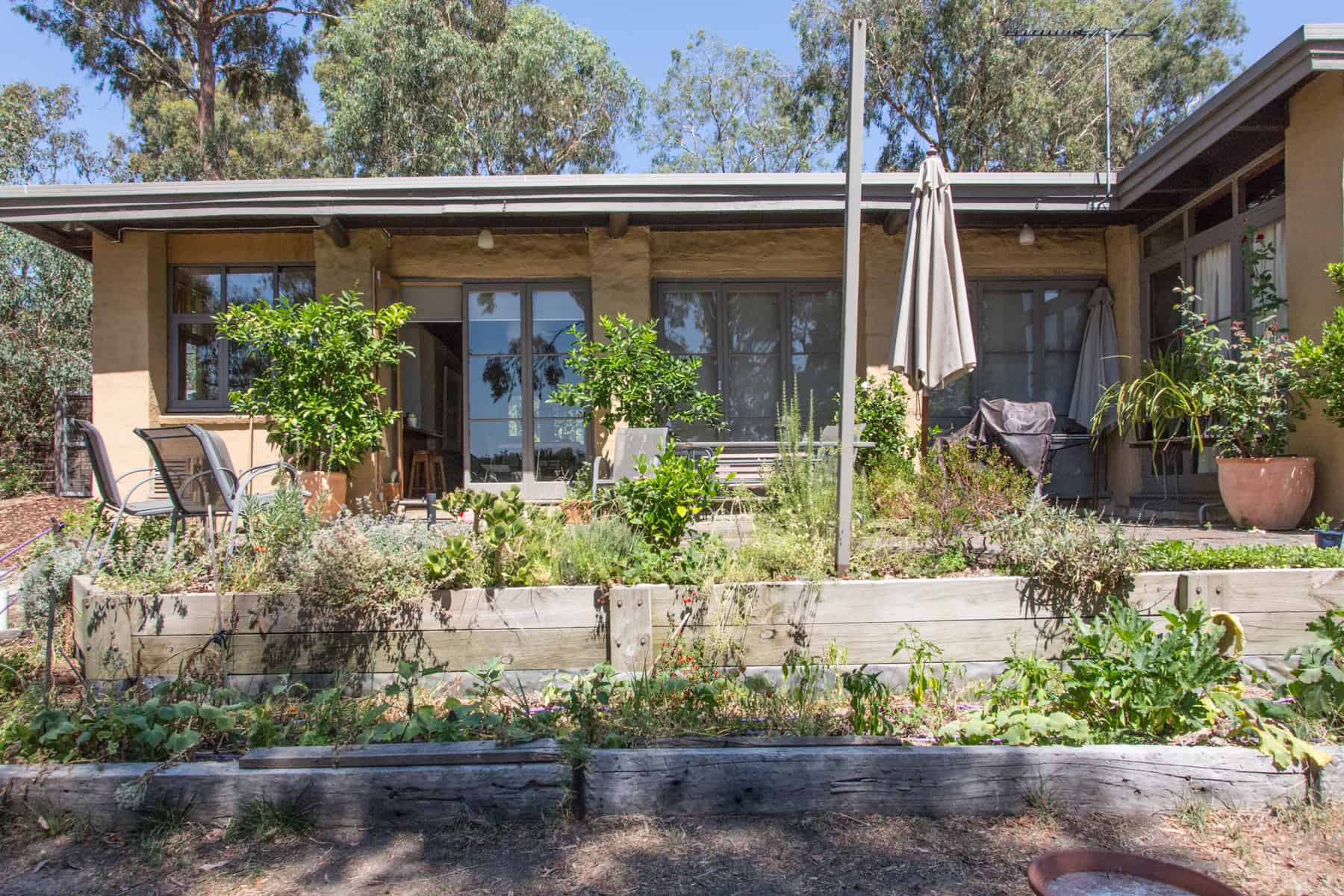 English house Lower Plenty, 1948. Extension added on right. Photo: Tony Knox
English house Lower Plenty, 1948. Extension added on right. Photo: Tony Knox
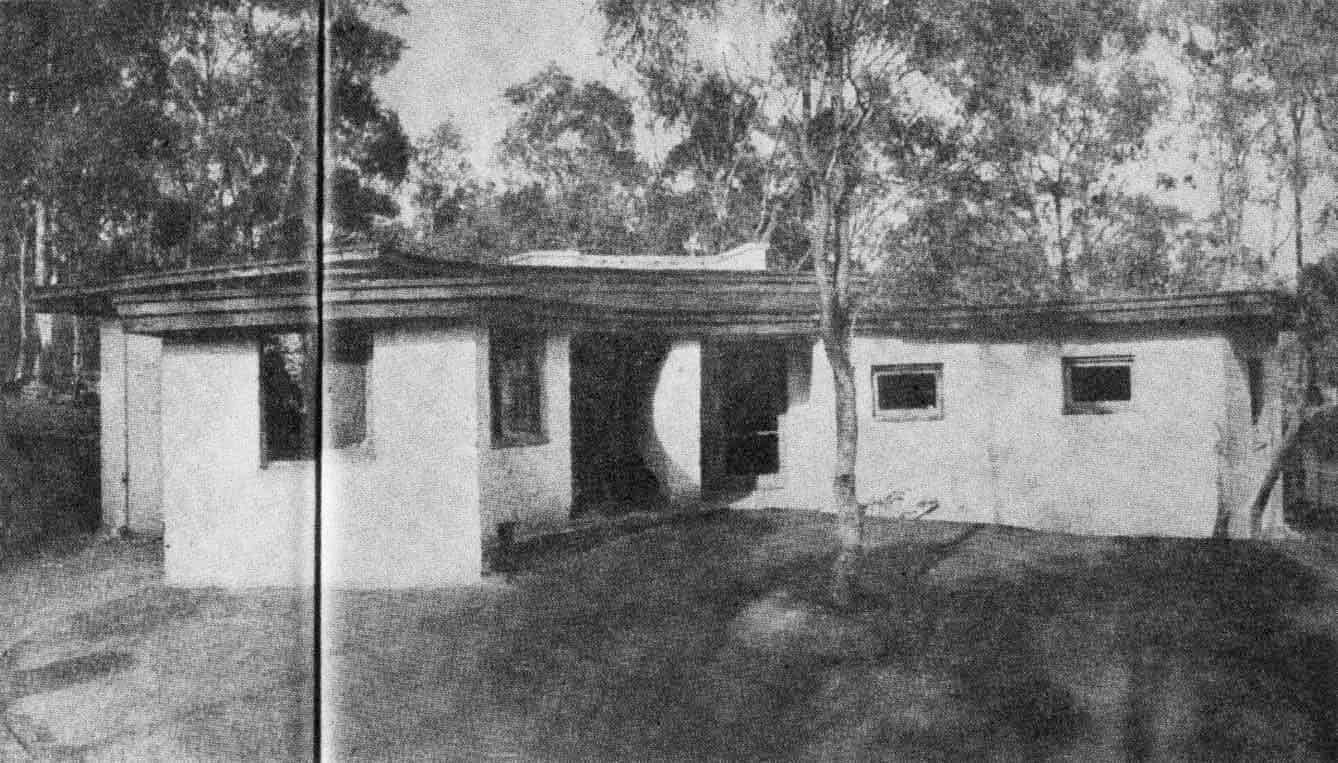 The Holmes house known as the Periwinkle, 1948. Photo Australian Home Beautiful February 1950 p31
The Holmes house known as the Periwinkle, 1948. Photo Australian Home Beautiful February 1950 p31
Knox was educated at Scotch College from 1925?27, after which he began working as a clerk at the State Savings Bank of Victoria in Bay Street, Port Melbourne, on £75 per annum. He took up a part-time accountancy course, but abandoned it to attend night classes at the National Gallery of Victoria Art School then under Bernard Hall. Here he met Sam Atyeo and Moya Dyring and during the 1930s he mixed with Melbourne?s leading promoters of modern art and design including Cynthia Reed, John Perceval, Sidney Nolan, Neil Douglas, Albert Tucker, David and Arthur Boyd, Fred Ward and writer Alan Marshall. 9 He visited houses by John Harcourt, the pioneer mud-brick builder and later was friendly with Matcham Skipper who had grown up in the house that Walter Burley Griffin had designed for his father Mervyn Skipper in 1927 in Eaglemont. Skipper remembered ?seeing the great architect coming over the hill to take tea with my mother, always with a bottle of wine, always in sports clothes?. 10
Glenard
In 1937 Knox married Mernda Clayton, a domestic arts teacher, at the Littlejohn Memorial Chapel at Scotch College. Having first searched in Camberwell, which they rejected for its neatness and formality, they found a boathouse to live in, which still exists, near the Yarra River in the long backyard of a property at Rudder Grange, Fairfield, for which Knox designed furniture. Two years later they bought a block of land in then unmade Mossman Drive at its junction with Glenard Drive, on the Glenard Estate, one of Griffin?s two remarkable subdivisions in Heidelberg. Their block was opposite two Griffin houses, the Lippincott House (1917) and Pholiota (1919?1920): the first designed in collaboration with Roy Lippincott, and the latter by Walter and Marion Griffin. Knox reacted instinctually to the ?spirit of the cave? Griffin?s design inspired, and noted that ?the more the neighbours complained about his leaky buildings, the more highly I regarded them. . . They were a natural extension of the landscape they occupied?. 11
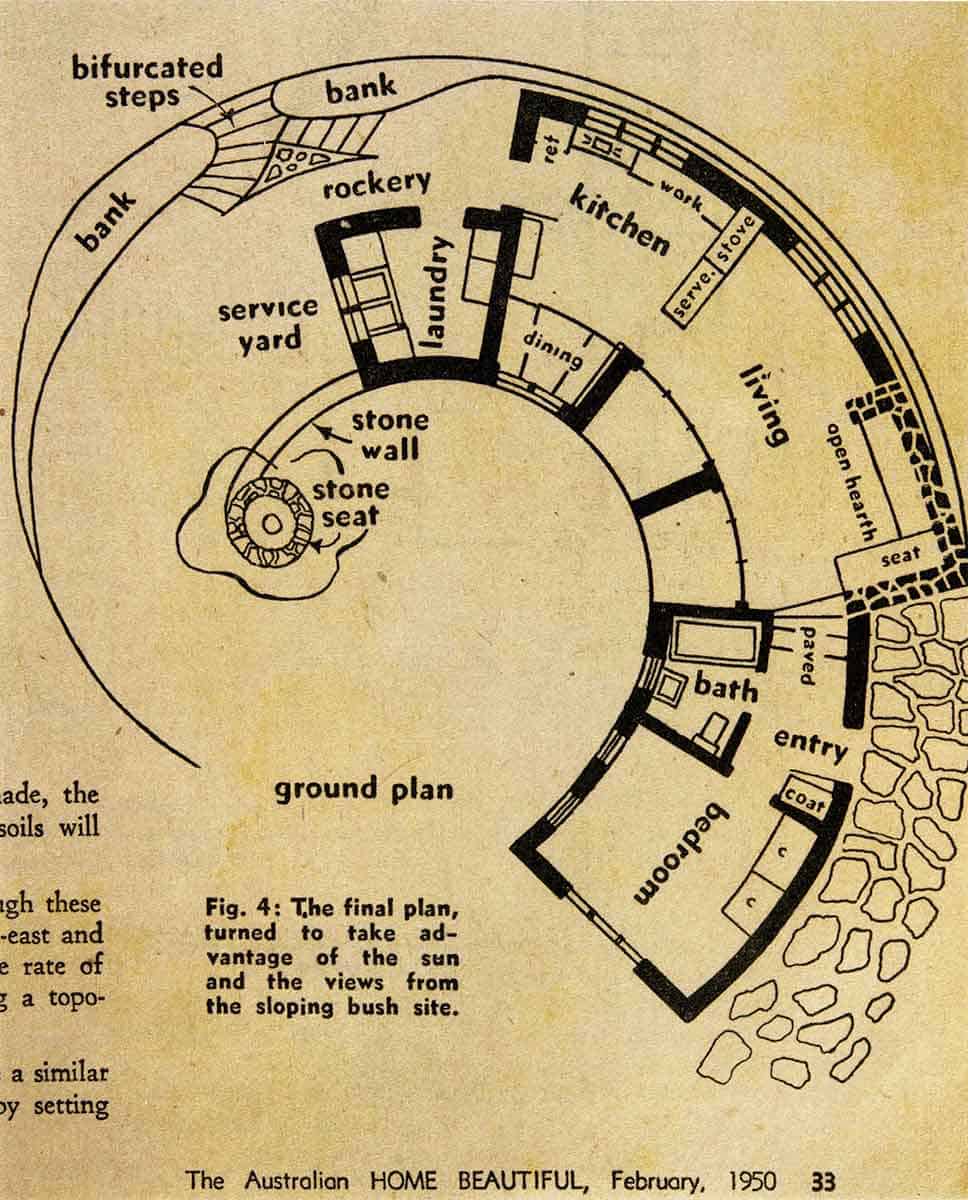 The Holmes house known as the Periwinkle 1948., plan. Australian Home Beautiful February 1950 p48
The Holmes house known as the Periwinkle 1948., plan. Australian Home Beautiful February 1950 p48
From there Knox rode his bicycle to the bank, now at Preston, which provided the loan for the ?Californian bungalow? house they began building just as World War II was declared. It used recycled materials, doors copied from Pholiota, random stonework and featured square-flagged terraces, 12 verandahs, and a strong relationship to the landscape.
Their neighbours included journalist Fred Aldridge, who in 1946 was a founding member of the Press Club of Victoria, Alan Nicholls, Fred and ?Puss? Ward and Murray Griffin, artist, who with his wife Norrie and their sons was living in the Lippincott house, architects John La Gerche and Bob Eggleston, and future architect John Pizzey. Generally on Saturday afternoons, the little community wandered down to the Old England Hotel for a couple of beers in the old part of the hotel, unaltered since its construction in 1847.
Frederick Romberg was also a neighbour at 30 Mount Eagle Road, East Ivanhoe, and when the two men heard about Montsalvat, which had a reputation among middle-class suburbia as a place of free love, they set off for this ?Holy Grail? of creativity. 13 Built of pisé de terre, adobe and recycled demolition materials, it was the work of Justus Jorgensen and his followers who had acquired eight hectares of land immediately after the Depression on which to build their utopian settlement with its common lifestyle and common ownership of possessions. Knox thought its inhabitants were interesting and intelligent, but their view of spirituality was diametrically opposed to that of his family. However from 1947 he became a regular visitor to Montsalvat, though was never a committed Jorgensen acolyte. 14
 Busst house, 1949. Photo: Tony Knox
Busst house, 1949. Photo: Tony Knox
Still with the bank, Knox began a part-time pottery course at Melbourne Technical College in 1941, but as the War came closer to home he realised ?for the first time just how useless he felt?. 15 So from 1942 he spent his spare time with the Volunteer Defence Corps, transferring to the Naval Auxiliary Patrol in 1943, then in 1944 to the Royal Australian Naval Volunteer Reserve. He served in Papua and New Guinea waters, particularly in the Trobriand Islands, on hmas Martindale, hmas Amohinie and hmas Stingray. On leave in Sydney, he became aware of Francis Greenway?s St James Church, its proportion and its brickwork, its beauty and completeness, on axis with Macquarie Square. It created an extraordinary sense of contained space. It was the genesis of my architectural career and understanding. In a single bound, my sights were raised from single structures to a new sense of visual totality and comprehension. In addition, I discovered that Greenway was in the direct line of Repton and the great eighteenth-century English Landscape tradition. 16
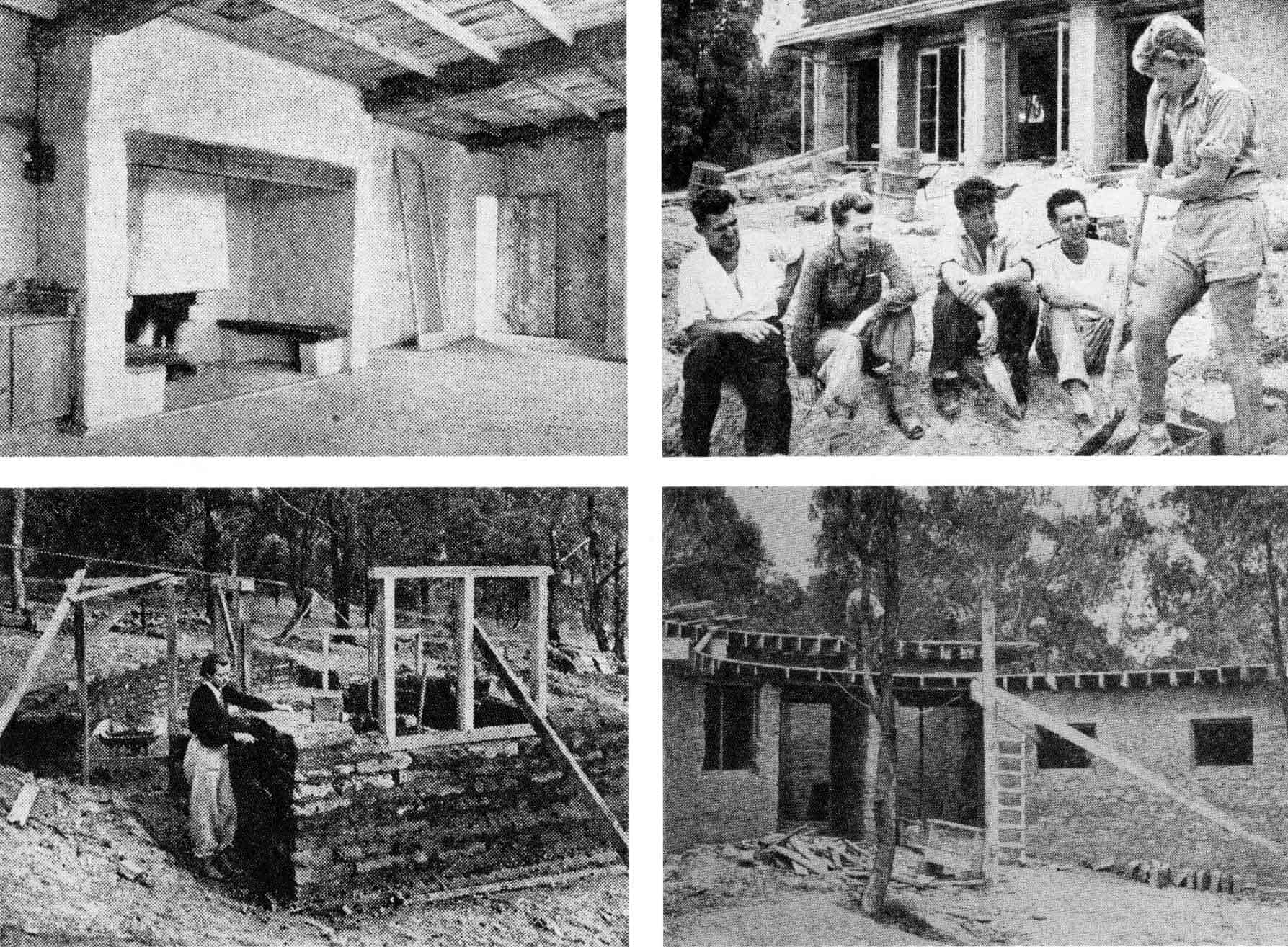 Top left English house interior Australian Home Beautiful June 1948 p28; Top righr Building the English house, Gordon Ford standing and from left, Laurie Mayfield, Sonja Skipper, Alistair Knox and Tony Jackson. Australian Home Beautiful 1948 p28. Bottom left Building "Periwinkle Hose" Australian Home Beautiful March 1950 p37. Bottom right Building "Periwinkle Hose" Australian Home Beautiful March 1950 p375
Top left English house interior Australian Home Beautiful June 1948 p28; Top righr Building the English house, Gordon Ford standing and from left, Laurie Mayfield, Sonja Skipper, Alistair Knox and Tony Jackson. Australian Home Beautiful 1948 p28. Bottom left Building "Periwinkle Hose" Australian Home Beautiful March 1950 p37. Bottom right Building "Periwinkle Hose" Australian Home Beautiful March 1950 p375
Discharged in Melbourne in 1945 as leading seaman, Knox resumed work at the bank but in 1946 took advantage of the Chifley government?s Commonwealth Reconstruction Training Scheme for Returned Servicemen and began a Diploma of Architecture and Building Construction at the Melbourne Tech. He had done part of Year 1 Building Construction Practice and Theory in the Navy by correspondence and so was placed in Year 2 for those subjects. He ?very easily? passed Years 2 and 3, which comprised the whole building side of the architecture course as well as the final-year exams. Then he left because ?I was thirty-four years old and desperate to get out of the bank?. 17
First building phase
During his architectural course, Knox had started building a house next door to his own in Glenard Drive, for Gerry Moore. It had a flat roof and was a local version of Wright?s Usonian house, with a courtyard and long lines of French doors and casement windows. Wynn Roberts, a Shakespearian actor, became Knox?s first foreman on this house and enjoyed building its stone chimney and low stone walls. Then in 1947, Knox was approached by Frank English, a returned serviceman who had accumulated £600 in deferred army pay, in addition to a hilltop allotment in Phillip Street, Lower Plenty, that commanded a superb view of the Eltham Valley and the Dandenongs.He had seen service in the Middle East and North Africa and so was familiar with mud brick, its economy and its inherent beauty. English was a ?gentle soldier;? he became a male nurse when discharged, and had a group of male friends who would share the house with him. 18 Encouraged by English, Knox built his first earth building there, a simple rectangular block on a concrete slab with a skillion roof, five Yellow Box tree trunks as beams, 900x600 mm mud brick piers, and with French doors facing the sun. 19 Knox asked Sonia Skipper, Matcham?s sister, to supervise the building and her workforce consisted of Larry Stevens, Gordon Ford and Tony Jackson, all returned servicemen. Knox thought she may have been the first female site foreman in Australia.
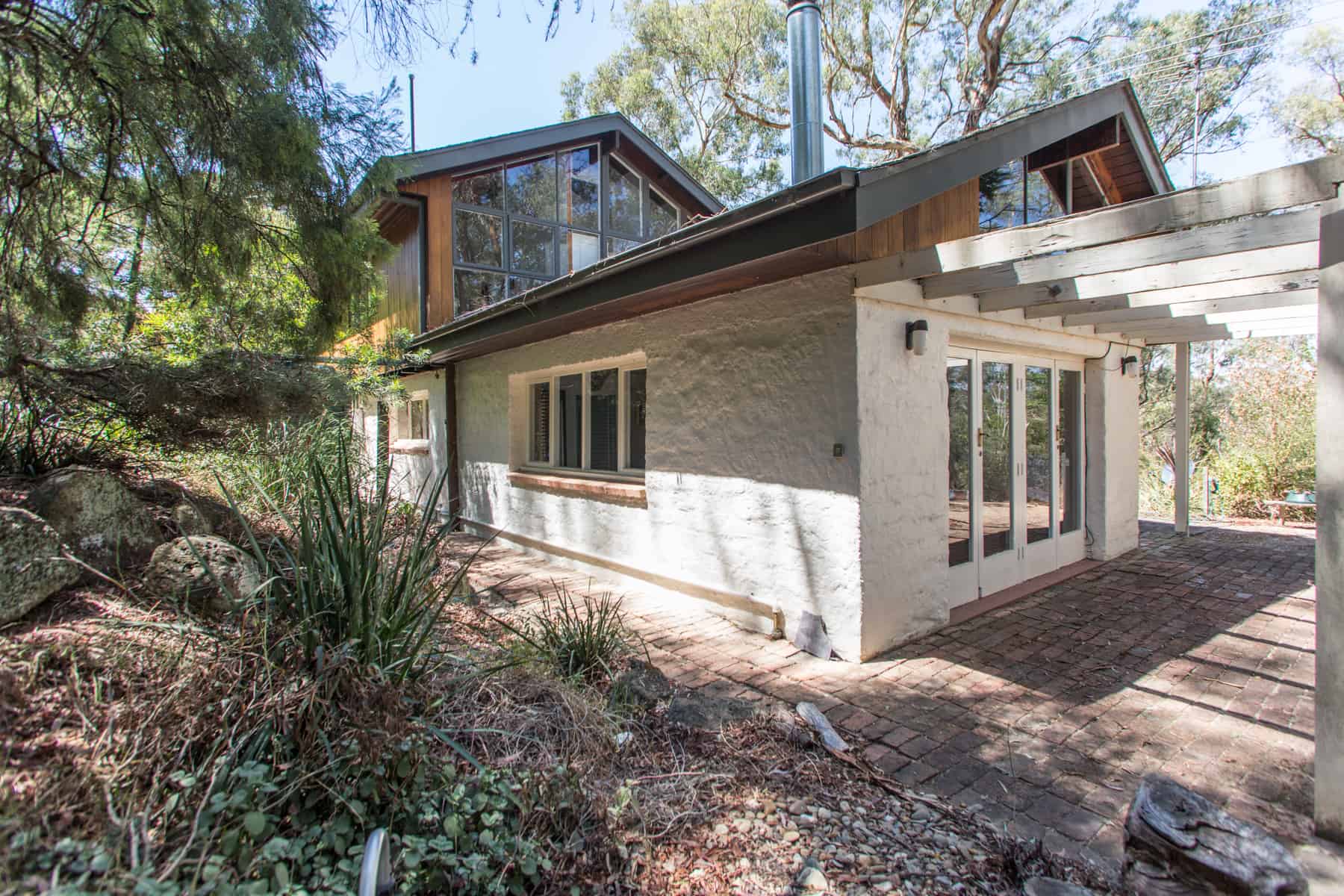 Downing Le Gallienne House Eltham 1948. Stage 1. Photo: Tony Knox
Downing Le Gallienne House Eltham 1948. Stage 1. Photo: Tony Knox
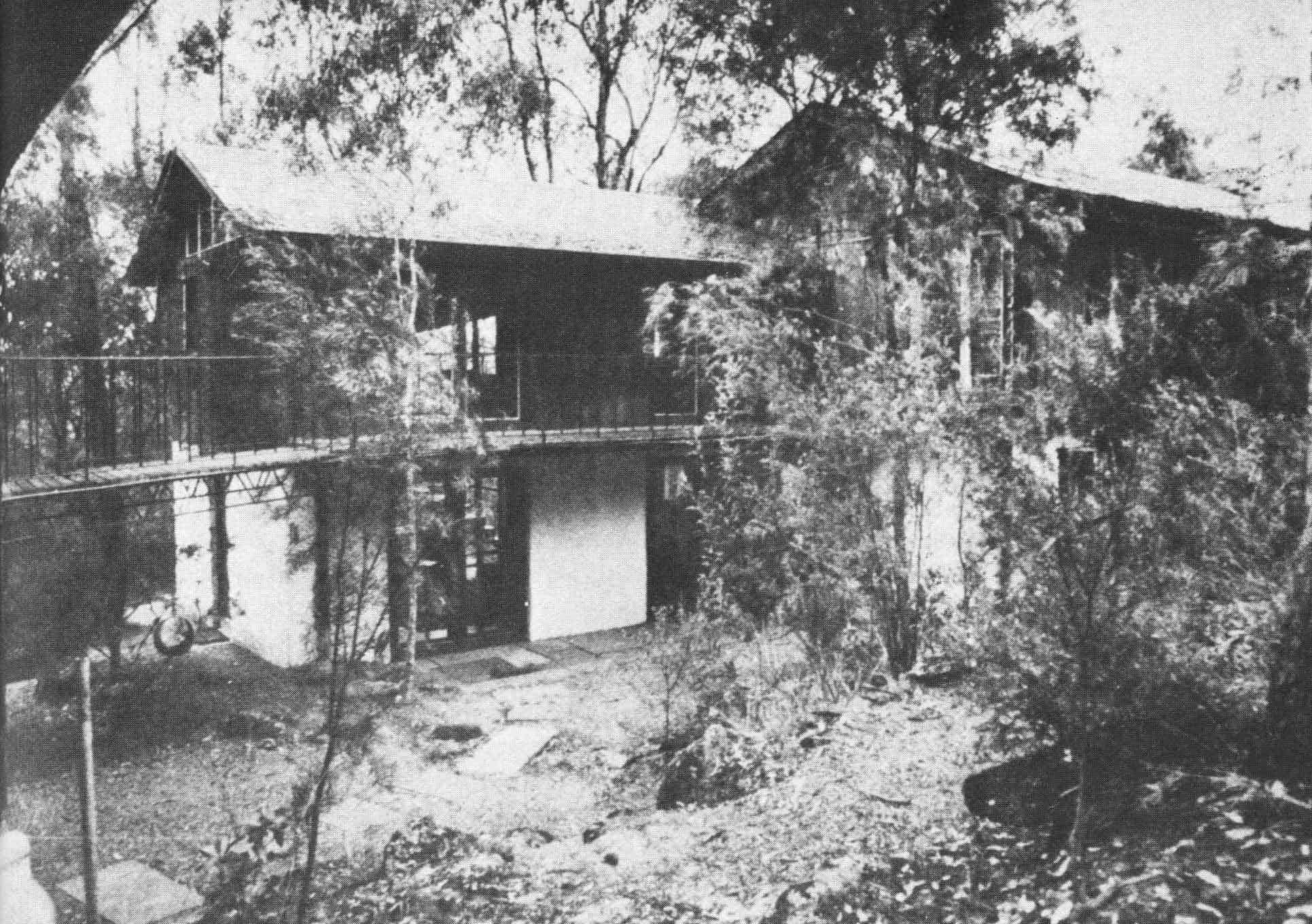 Downing Le Gallienne House Eltham 1948. Stage 2. Landscaped by Ellis Stones. Photo: Alistair Knox Living in the Environment p42
Downing Le Gallienne House Eltham 1948. Stage 2. Landscaped by Ellis Stones. Photo: Alistair Knox Living in the Environment p42
G F Middleton of the csiro Experimental Building Station, Ryde, nsw, had been researching mud brick (pisé) and had published pamphlets about it. 20 These pamphlets, brought to the local council?s attention by Knox, persuaded them to agree to a permit, the first building permit for an earth construction building in Victoria. It was a cost-plus job, and when English?s deferred pay ran out, he refused to pay further, and Knox had to make up the difference. But Robin Boyd published it in his Age Small Homes Service weekly article and also in Australian Home Beautiful and Knox wrote articles on it for the Age and the Herald. 221
In 1948, following long-service leave, Knox resigned from the bank to concentrate on building. His workers and clients were drawn from the immediate locality, including film-maker Tim Burstall, artist Clifton Pugh and landscape architect Gordon Ford.
A pisé studio for William Macmahon Ball followed, and then the Periwinkle House for Mr and Mrs Jack Holmes in 1948. Sonia Skipper again supervised and Tony Jackson, Ted Howard, Neil Douglas and Horrie Judd provided the labour. This was a small, onebedroom house at the north end of the valley, spiralling out from a seat around a tree. 22 It a had slab-on-ground construction, but only 76mm thick ?with very little reinforcement?, a method Knox believed he had invented until he discovered that Frank Lloyd Wright had been using it on his Usonian houses for over a decade. Knox records that the CSIRO came to see it as they were writing their own standard at the time, and ?decided to start again? on seeing the Periwinkle. Knox made another loss. 23
However, as Miles Lewis has noted, even by the time of the Great War several raft slabs on ground had been built in Australia, one of the most interesting being that of the South Melbourne Gasworks. But it was only after World War II that the flat slab on the ground became a standard element for domestic use in Australia, encouraged by a Commonwealth Experimental Building Station report in 1955. 24
In Albuquerque, New Mexico and Mexico City, a similar slab-on-ground movement was also emerging, with Luis Barragán and Vilchos Ricardo Legoretta reviving the Spanish hacienda style. It took middleclass suburban Melbourne over twenty years to accept it, and an additional fifteen years in Sydney.
The Busst House (1948?49) had a bituminous felt flat roof and curved wall, built by Horrie Judd assisted by Les Punch, a railways employee, and Gordon Ford. 25
Here, Sonia was given full rein over the ?artistic on-site decision-making? and execution. Her finishing subtleties embellished Horrie Judd?s powerful primitivism, built by long-haired staff. This was more complex split level slab construction. As concrete trucks had not yet appeared in Melbourne, Horrie decided he and Gordon should perform the Herculean task without any machinery: in one day they mixed 55 cement bags with ten tons of sand and screenings. However, they did use a crawler tractor and dynamite blasting to form the site. Complete construction was staged over 15 years.
In 1948 Dorian Le Gallienne and his lifelong companion Professor Richard (Dick) Downing, commissioned a weekend house in mud brick on the river at Eltham. Over the following 15 years Knox designed and built four different structures on their property. He recalled Dorian and Dick had a comprehension of the total landscape in its relationship to humanity that I had never before encountered. In addition, they had an ability to see quality where others could not. Like everyone else at this time, I was itching to be clever in design. It was Dorian?s explanations which caused me to slow down and think in simple, timeless proportions - to relate to the powerful landscape, rather than try to outdo it. 26
Ellis Stones was the landscape architect on the project and Gordon Ford was one of his labourers, ?his best pupil? according to Knox. Clifton Pugh also laboured on this project, making mud bricks. The Sibbel brothers were the foremen.
In 1948, four women proposed to build three timber houses on eight hectares in a Templestowe orchard: a joint house for Polly and Guelda Pyke and separate ones for Val and Yvonne Cohen (the Pyke-Cohen Houses). They had independent means, and this gave Knox his first chance to produce three sizeable houses. It was an idyllic scene, particularly as these would be almost the first houses that could be seen from the west, across the Yarra Valley, before any orchards had been subdivided.
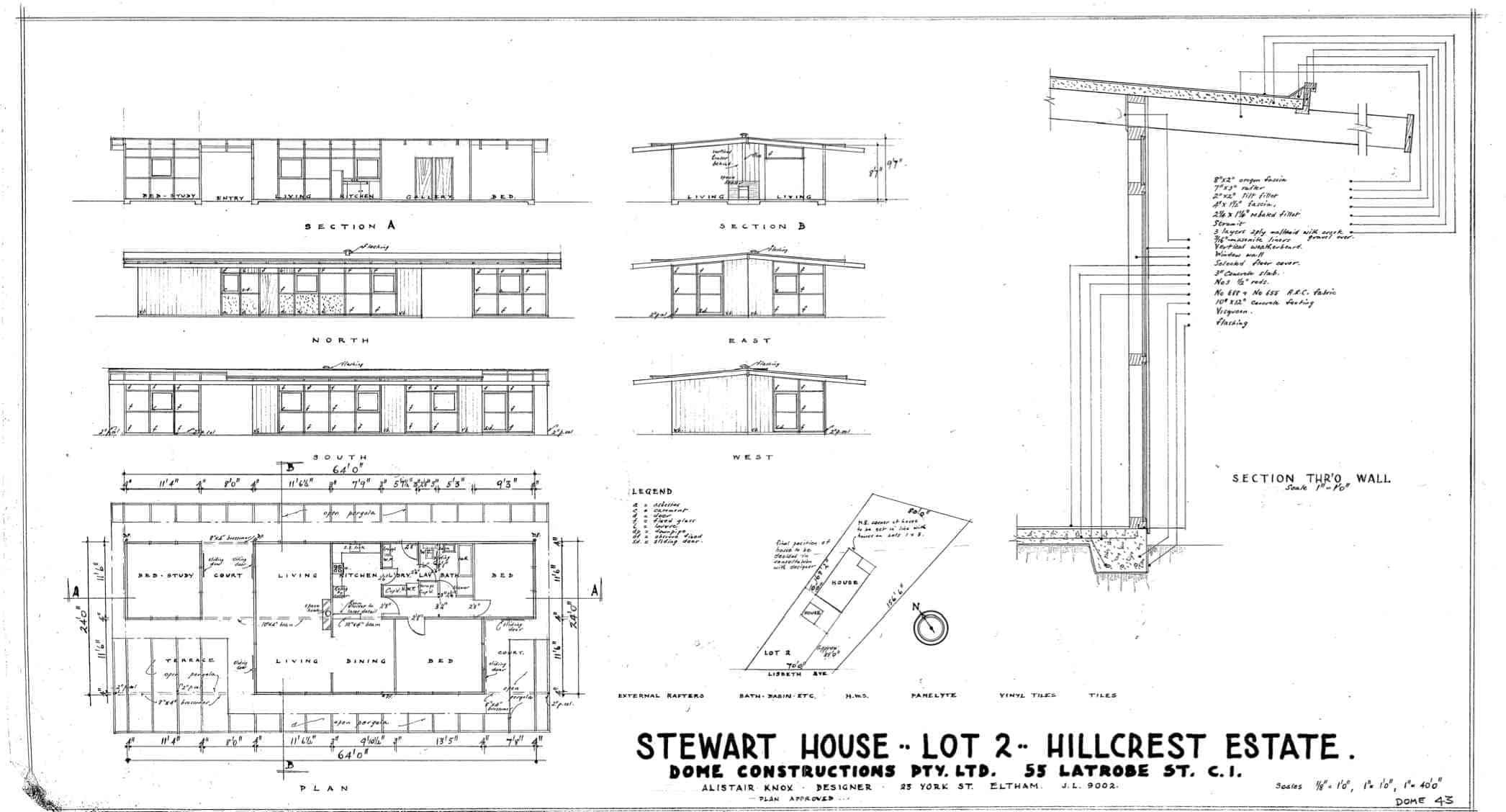 Stewart house for Dome Constructions, Donvale. circa 1958
Stewart house for Dome Constructions, Donvale. circa 1958
Knox moved his family to Eltham in 1949. Five years later, when Mernda was working at the Brotherhood of St Laurence in Fitzroy, she was hit by a car and killed while crossing Brunswick Street. Their son, Tony Knox, was 15. By this time Knox and Mernda had already separated and later that year Alistair married Margot Edwards who worked with Ellis Stones as a pavior and planter.
With a team of builders that included Ford, Judd, Douglas, Jackson, Cyril Jacka, Peter Glass, Wyn Roberts, Tim Burstall, Alan Green, Hal Peck, and Brian Stack, Knox?s practice expanded and he completed in quick succession the Murphy?s Creek Homestead, near Tarnagulla, and houses for Tim and Betty Burstall, Freddie and Verna Jacka, the Clendenens, and Hal and Joy Peck, all very near to each other, off Napier Crescent, Eltham.
From 1957, he also completed a sequence of numerous and varied small houses on the Hillcrest Estate, in Lisbeth Avenue, Donvale, for Dome Constructions Pty Ltd of 55 La Trobe Street, Melbourne. 27
Modular architecture
Knox built his second family house on the corner of the Pine Trees property in York Street, Eltham, between 1956?1958. It was rectangular, with a slab-on-ground, and a low-pitched roof with a large central ridge beam, vertical timber cladding and an extensive window-wall. This was of Knox?s own design, on the module of its 1,220 mm Stramit roof, which was supported on exposed dressed oregon beams. The roof was clad with malthoid bitumen and creek gravel, later replaced with Klip-Lock steel sheeting. It had non-load bearing internal timber stud walls lined with V-jointed leather-patterned tempered Masonite, and a brick chimney.
After this prototype building, Knox virtually always used modular design (1,220 mm, or 4 foot, then later 900 and 1,800 mm modules) 28 with point loadings on the module centre-lines, and the simplest number of junction devices for the medium and materials used. They had timber or brick infill, but the window-wall comprised up to 60% of the walls. He exposed the timber beams in ceilings, and used clerestory lighting, initially with 150x25 mm hardwood boards lining the ceilings, but later strawboard that would span the 1,200 mm between rafters, though later he returned to timber. He almost always avoided plaster, preferring organic materials and finishes. He insisted that two elements never be used where one would do, that everything should count, leaving a sense of inevitability, which he claimed to derive from Wright. He also valued timeless worn down shapes. He fully realised that many thought of his preferred building techniques and finishes ?primitive and unfinished,? but his motto was as Goya?s, that: ?A painting, the effect of which is true, is finished?. 29

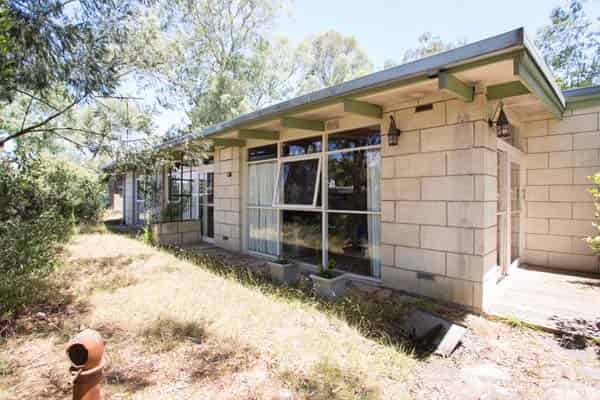
|
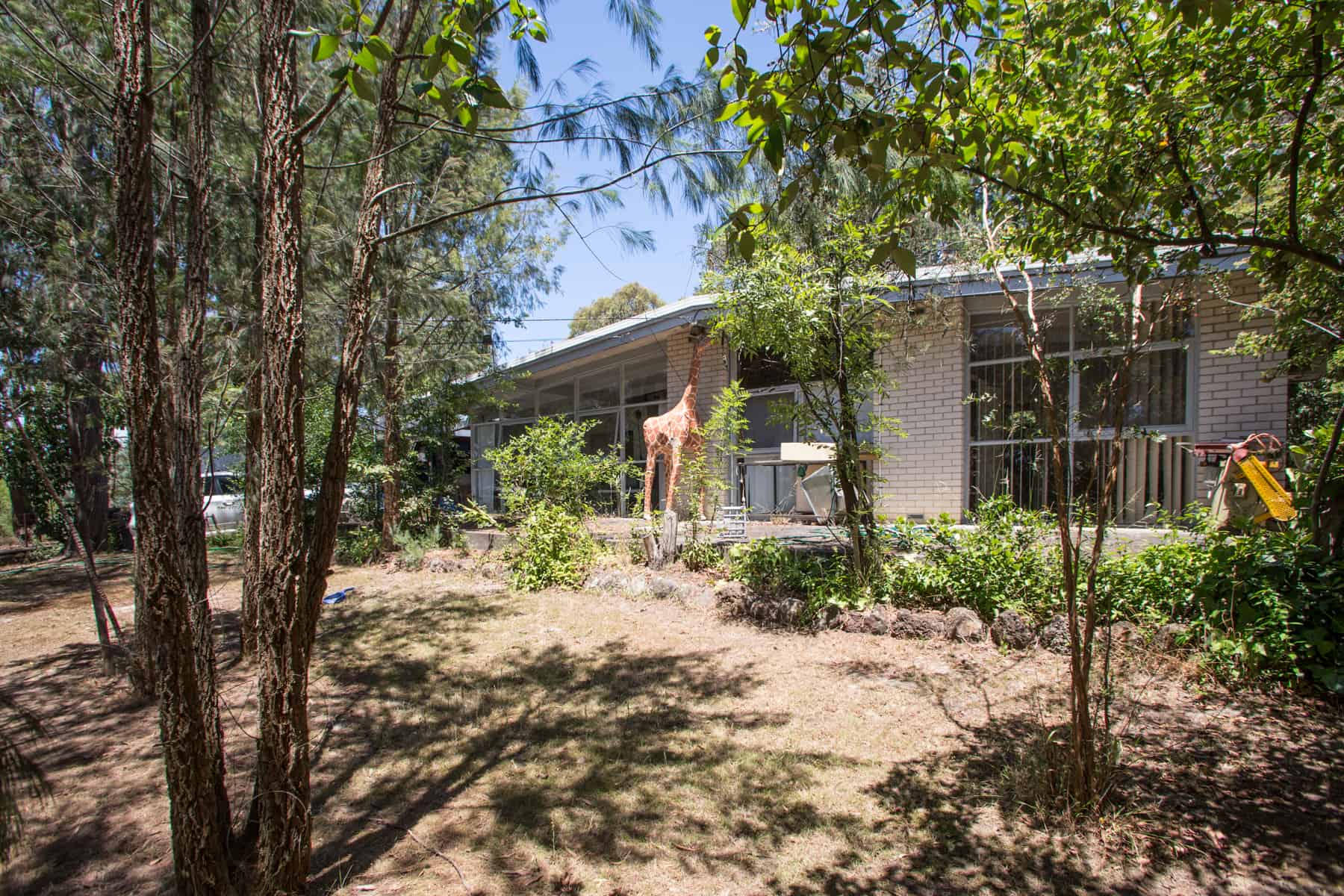 .Houses for Dome Constructions Hillcrest Estate, Donvale 1958-1960 showing timber, Mt Gambier stone and brick construction Photos: Tony Knox
.Houses for Dome Constructions Hillcrest Estate, Donvale 1958-1960 showing timber, Mt Gambier stone and brick construction Photos: Tony Knox
|
The credit squeeze of 1961 had a deleterious effect on the Knox building enterprise. When architect Suzanne Dance worked for Knox about this time at York Street, the only employee was landscape designer Peter Glass, drafting. 30 But as early as 1961, Knox discovered he had a following, the ?Knox Box? watchers, and he lamented that builders partly imitated his work for greater profit.
Shortly after this, he and Margot managed to obtain land at 2 King Street, off Mt Pleasant Road, Eltham, from an orchardist friend, Eddie Anderson, and he began work on a large mud-brick house there for his expanding family.Built in adobe with a brick and stone floor, it was arranged about a covered internal courtyard lit by a clerestory window, the four external walls had 2,400 mm openings at the ends and 3,700 mm at the sides, open to the exterior and surrounded by large peripheral informal sleeping and living zones. There were no doors from the central space, but splits of bullock hides were sewn together into hangings to draw across at each end, as Griffin had done at Pholiota. 31 A folding panel made from old pew backs, could close one of the larger openings. The discipline of a tight budget produced ?an aura of inspired improvising.... [The building process] recaptured the early days of sun-tanned brick-makers and water shortages?. 32
Architecture and landscape: the second building phase
Knox enrolled part-time in the town planning course at Melbourne University under Neil Abercrombie, son of English architect and town planner, Patrick Abercrombie. 33 In mid-1962, with John Duncan, Margaret Hendry, Mervyn Davis and Peter Glass, he attended the initial meeting to discuss forming a professional institute for landscape architects (to be known later as the Australian Institute of Landscape Architects or aila), at the home of Ellis Stones. This led to a number of commissions involving landscape design.
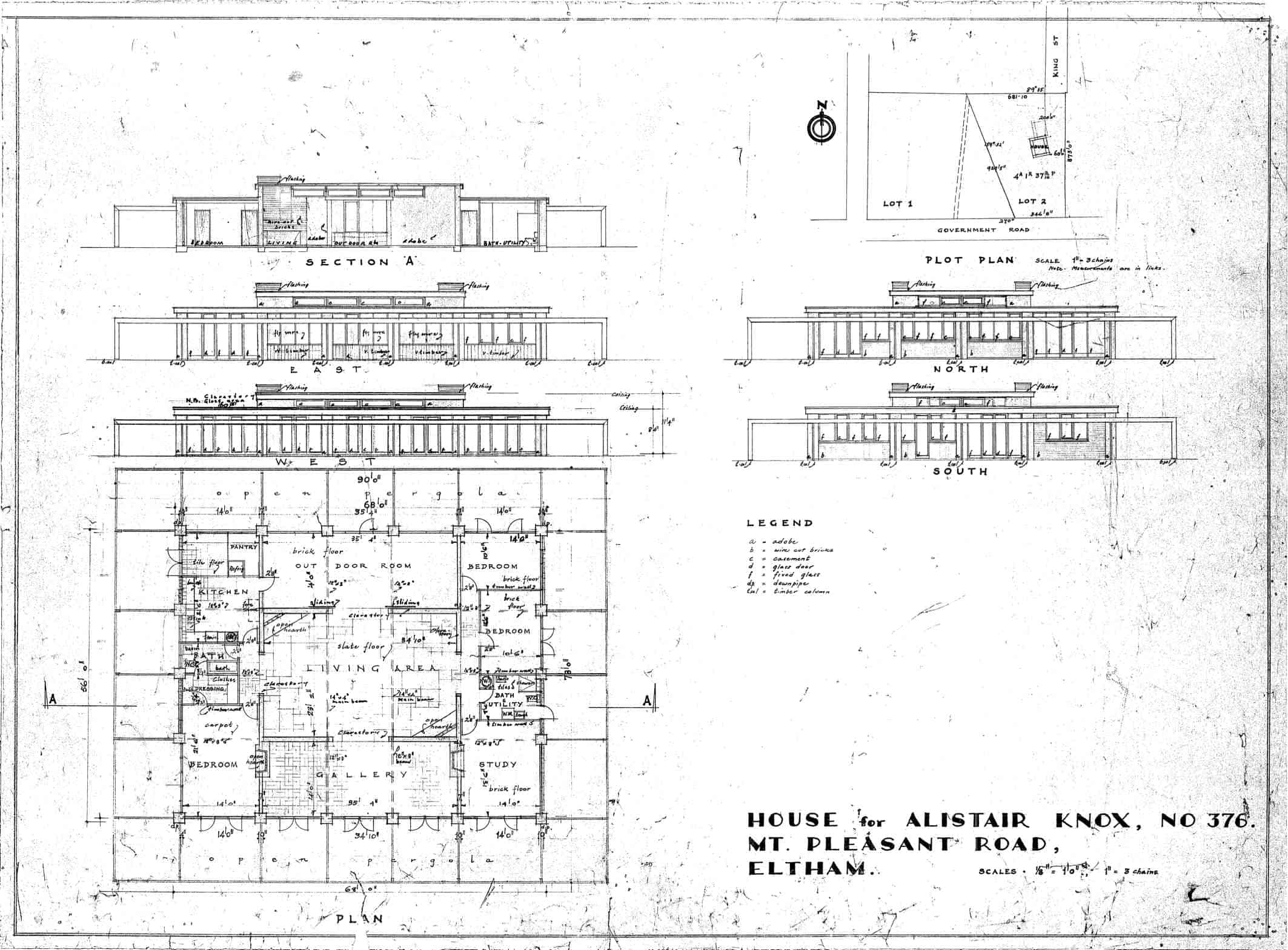 Knox house 3 1961
Knox house 3 1961
In 1963, George Clarke of Urban Systems invited him to design the landscape for a neighbourhood in Woden Valley, Canberra, which was implemented, although Knox was very disheartened when his Griffin-like system of private commons was deleted.
His 1965 commission for Cobungra Station, between Omeo and Mt Hotham, produced a more daring response. Influenced by the Picturesque landscapes of Lancelot ?Capability? Brown, he flooded two creeks to produce artificial lakes and secondary water supplies while retaining the forested ridgelines to arrest erosion. He sited the house with care, considering the ancient worn landscape and the need for solar access and warmth in a cold climate.
He sought local materials, an old timber bridge and slate from Mt Hotham. At the time Eric Wilson noted in Australian Home Beautiful that tying a building intimately and sympathetically to the landscape was ?a quality that seems more prized in Melbourne than other [Australian] capital cities, if the success of the designer Mr Alistair Knox is any criterion?. 34
 Knox house 2 1956. Photo: Tony Knox
Knox house 2 1956. Photo: Tony Knox
 Knox House 3 Eltham 1961. Photo: Tony Knox
Knox House 3 Eltham 1961. Photo: Tony Knox
Between 1970 and 1980 Knox?s second phase of more sophisticated designs in mud brick, stone and timber emerged. In 1971, he went into a partnership with Peter Hellemons, his foreman who controlled the building, while Knox concentrated on design. For him, the design process was fluid, adjusting to the client needs. This was a productive period when his work was more widely recognised. The Wain House, Warrandyte (1972?73) was the first of a series of owner-built and sub-contracted designs, but designed and supervised by Knox. By 1975, earth construction had become common in Eltham. The Knox office, which usually had about four employees, including John Pizzey, Peter Jarvis, Barbara Telford, and Robert Marshall, was constantly approached with enquiries by visitors and phone calls from the eastern states. John Pizzey qualified as an architect and town planner and became an associate in the firm.
By 1970, Knox had joined with local landscape designer Ivan Stranger, who with Gordon Ford and Peter Glass designed the town park, which was established on six hectares at 829 Main Road, Eltham, in 1975. It had been the local rubbish tip in the centre of the town and Knox had been determined to turn the eyesore into a park; fittingly it now carries his name, Alistair Knox Park. He also moved to save a stand of Candlebark trees (Eucalyptus rubida) on the Jelbart Estate (off Arthur Street and Hartland Way), Eltham, which was being developed by Development Underwriters Ltd. They located the required open space at the rear boundaries of the allotments, forming a series of walkways, or linear parks, along the gullies, similar to a Radburn development and perhaps influenced by Griffin?s Glenard Estate.
 Knox house 2 1956. Photo: Tony Knox
Knox house 2 1956. Photo: Tony Knox
Later as a member of Eltham Shire Council from 1973 to 1975, and President in 1975, Knox influenced the development of the Woodbridge Estate (south and east of Arthur Street) by installing power lines underground, reducing road widths, deleting some footpaths, and all front fences. He would have preferred to eliminate all paling fences and introduce indigenous planting across Eltham. Like Robin Boyd, Knox despised the ?dreary suburbia? of ?dreaded paling fences? in both visual and social senses; yet he did not disparage suburbs as such, and often spoke of the possibility of a ?natural garden suburb? and ?environmental living? on a suburban block. 35
Knox?s wider activism and municipal politics were possibly derived from his evangelical spiritual life. He worked to prevent a restaurant proposed for an island in the Royal Botanic Gardens, and the subdivision of the Little Desert for agriculture in the late 1960s, and to prevent what is now Westerfolds Park, Templestowe, being subdivided for housing. He argued against the expansion of Melbourne: ?The problem of rapidly inflating land prices keeps spelling out that major Australian cities are too large, and that their continued growth reduces the quality of life... We have a land that is capable of real decentralisation?. 36
Knox became consultant to activist community groups across Melbourne, fighting inappropriate subdivisions and alienation of public space, forming allegiances with local councils to prepare master plans and management proposals for the Yarra River, such that he admitted to using the title ?landscape architect? purely for political advantage. 37 Knox, Stones and Grace Fraser were among the most active in early landscape conservation disputes in Melbourne. 38
Despite, or because of his admiration for Griffin, Knox was dismissive of ?over-planned? Canberra.39 In 1973, he designed a house there for John Nicholas, an ardent admirer of Frank Lloyd Wright. The site was difficult with winter solar access in one direction and views in the other. Its ?sickle-shape? of colliding cylindrical flat-roofed forms, reflect the boulders, hills and curving creek of the landscape. 40
When asked by the Presbyterian Board of Missions of Australia to design a shelter for the Pitjantjatjara people at Ernabella Mission (now Pukatja) in the Anangu Pitjantjatjara Yankunytjatjara Lands in South Australia, he used self-supporting arched corrugated steel sheet because it was simple to make, was inherently structural, provide a functionally flexible space that the occupants could evolve for themselves, and was easily portable, since would its occupants not continue live in a place where someone had died. 41 He noted ?They seem so tied to the landscape that they appear to dissolve into it and it seems a crime to design buildings which separate them in any way from it?. He used a similar approach of cross-vaulted superimposed corrugated sheeting over a cruciform plan for ?hurricane-proof? housing following Cyclone Tracy in Darwin in 1975 for clients David and Robin Freeman. 42
Knox published Living in the Environment in 1975 followed by Alternative Housing and We are What We Stand On. A Personal History of the Eltham Community in 1980. In these books, he reveals himself as an eloquent writer and through them he became known beyond Australia. Lynnsay Prunotto learnt of him in South Africa, wrote briefly of him in an article on ?vernacular? architecture, and then came to live and practise in Eltham.
 Original sketch plan of the Nicholas House Canberra 1973. Alistair Knox Living in the Environment p90
Original sketch plan of the Nicholas House Canberra 1973. Alistair Knox Living in the Environment p90
Amongst works from this period, Worawa College, Strathewen (1981), a hostel and dining hall within Shepparton tafe, was designed to be built by the students. The Anver House, Doncaster East (1981), is a compatible neighbour to the Merchant Builders houses designed by Graeme Gunn and others while the Duff House, Donvale (1982), is by contrast very large, split level and dramatic. At Millicent, South Australia, the Hooper House is reminiscent of Robin Boyd?s Baker House near Bacchus Marsh with a landscaped central courtyard. Allan and Lee Lim Joon were some of Knox?s most loyal clients: their 1983 house at Somers was the third he had designed for them. The first was hexagonal and was supervised by Kevin Borland. The 1983 Shugg House at Shoreham, though not large, was very dramatic. The 1984 Roberts House at Strzelecki was designed to respond to its context of beautifully rounded hills. Bohdan Kuzyk recalls driving to that site and Knox?s unexpected enthusiasm for Gregory Burgess?s complex Hackford House at Traralgon that they passed on the way, which possibly influenced the design of the Roberts House.
Last years
In the last years of his life Knox was widely acclaimed as a building designer and landscape architect. He wrote for newspapers, spoke on radio, and hosted ?open houses? and student visits to Mount Pleasant Road to demonstrate his building and landscaping concepts. He frequently lectured on environmental design, architecture, building and landscape, and the aesthetic value of the Australian environment. After a lecture at Melbourne University in 1965 Knox invited the students to his house and studio; every year Allan Willingham took students there from the Gordon Institute, Geelong, and when Peter McIntyre was Professor of Architecture at Melbourne University, he also led student groups to visit Knox between 1988 and 1992.43 For his part, Knox spoke admiringly of Boyd, Gregory Burgess and Suzanne Dance, who Knox claimed was ?the best designer he?d worked with?. 44
Knox had connections with many of Victoria?s eminent modernist architects. Kevin Borland signed at least one of Knox?s drawings as nominal architect. He was a friend, employer and collaborator of the important landscape designers Stones, Ford and Glass. His work can be comfortably placed within the context of post-war Melbourne Modernism. Furthermore he was instrumental in the development of the next generation of regional builders and designers including architects John Pizzey, Morrice Shaw and Robert Marshall, building designer Bohdan Kuzyk, builder Peter Jarvis and ?countless? ownerbuilders.
|
 Knox drafting office Eltham. Photo: Tony Knox Knox drafting office Eltham. Photo: Tony Knox
|
His design of the Coller House in Eltham (1973?1974) was built by his son, Hamish Knox, who remains a builder utilising recycled materials which he calls ?sculpture in structure?. His youngest son, Alexander, is a successful sculptor, another son, Macgregor, designs and builds sinuous organic furniture, while his eldest son, Tony, had worked for his father as a carpenter, and his second wife Margot Knox was an acclaimed painter and mosaic garden designer. Some of his details and his aesthetic may have been adapted by Graeme Gunn for Merchant Builders and he probably influenced Charles Duncan. Knox?s Romantic and spiritual aspiration survives in the more eclectic and spiritual work of Gregory Burgess who worked for Knox, making mud bricks, in the university vacations from 1964. 45
Conclusion
In general, Knox?s approach was modernist in its embrace of light, space, proportion, unadorned minimalism, modularity and orientation. His buildings sit empathetically within the natural landscape and his materials were nearly always those he perceived as ?rustic, and reclaimed?; he sought to build homes for people, not monuments to their architect. Sonia Skipper observed that his houses ?were for people and suit their lifestyles. At Montsalvat, Jorgy?s interest had been purely aesthetic ? he didn?t care what went on inside a building as long as the proportions were right and it fitted into his overall [visual] scheme. Alastair would take me along when interviewing a prospective client, walk over the land with them, discuss their lifestyle and how they might like their home to be arranged. This approach I found most intriguing?. 46
He referred to historical architecture, including the Parthenon with its perfect siting, the ?natural? landscaped gardens of Humphrey Repton and ?Capability? Brown and the built works of Francis Greenway. He felt that medieval architecture, based on the human form, resulted in emotive spaces. Oddly, although he must have been aware of them, Knox did not refer to architects and theorists of the English Arts and Crafts movement such as John Ruskin, William Morris, C R Ashbee and William Lethaby yet some of his writing is almost Ruskinian: ?There is a spirit in re-used material in the same way as there is poetry in some words, which when we use them recall other scenes. It?s not corny. It?s elemental experience and the stuff of life?. 47
He also admired the Cairo architect, Hassan Fathey, who pioneered appropriate technology for building in Egypt, especially by re-establishing the use of adobe and traditional building designs, and, Pier Luigi Nervi, who he felt made concrete seem light and fluid and was ?the world president of the instinctive inventors association?. 48
Knox was responsible for some significant technological and administrative innovations. Sonia Skipper may have been the first female foreman in Australia when she took on the job of supervising construction of his early houses. His building processes were participatory. He preferred the work of informed amateurs as site workers. He also proposed establishing centres to store modular sheet materials for domestic builders. In the early 1970s, at his Mount Pleasant Road house, he hosted regular ?Earth Days.? He encouraged owner-built and subcontracted designs, which he designed and supervised.
Knox remained closely identified with the Eltham community. His and Margot?s home offered accommodation and support for two generations of painters, potters, sculptors, poets and thinkers. He was a Shire Councillor and in his year as President, Alistair Knox Park was established. Alistair Knox died in 1986 while visiting clients at Sunnycliffs, near Mildura, with his last assistant, Bohdan Kuzyk at his side. He is buried in the Eltham Cemetery.
Richard Peterson is an architect and retired conservation consultant, who taught at RMIT University for 20 years. Bohdan Kuzyk is a building designer practising from Eltham. He worked with Knox for three years
.Endnotes
1 Most of the drawings survive. The jobs are numbered chronologically beginning at no 101, although not always dated, see http://alistairknox.org/building/list?street=&suburb=&client=&year_built=1958&jobnumber=&submit=Find
2 Knox properties receive 11 mentions on the Victorian Heritage database; 4 properties are identified but not protected, 7 are covered by heritage overlays in municipal planning schemes, 1 is mentioned but not recommended for protection and 1 is on the National Register.
3 Quoted in Fay Woodhouse, ?Knox, Alistair Samuel (1912?1986)?, Australian Dictionary of Biography, National Centre of Biography, Australian National University, http://adb.anu.edu.au/biography/knox-alistair-samuel-12750/text22995, accessed 26 December 2013.
4 Alistair Knox, Living in the Environment, Birregurra South: Compendium, 1978, vi.
5 Alistair Knox, A Middle Class Man: An Autobiography, chapter 1, alistairknox.org/book.
6 The Free Presbyterian Church of Australia (Felix), founded in 1846, was one of three Presbyterian ?sects? which refrained from amalgamating into the Presbyterian Church in Australia (Continuing) in 1901. It continued its separate existence until 1953 when it amalgamated with another of the separatist groups, the Synod of Eastern Australia also founded in 1846. It survives today as one of the nine Presbyterian sects that remain outside the Uniting Church of Australia founded in 1977. Knox was a member of the Presbyterian Church of Australia, earlier in Montmorency, then in Eltham (about which he wrote a short history), until his death.
7 Knox, A Middle Class Man, chapter 4.
8 Knox, A Middle Class Man, chapter 5.
9 Recounted to Bohdan Kuzyk, and John McLaren; ?Marshall, Alan (1902?1984)?, Australian Dictionary of Biography, National Centre of Biography, Australian National University, http://adb.anu.edu.au/biography/marshall-alan-14935/text26122, published in hardcopy 2012, accessed online 23 March 2014. http://adb.anu.edu.au/biography/marshall-alan-14935
10 Matcham Skipper Obituary, www.theaustralian.com.au/arts/sculptor-and-adventurer-matcham-skipper-forged-creative-life-fromthe-bohemia-of-montsalvat/story-e6frg8n6-1226024981765
11 Knox, Living in the Environment, 31, and recollection of Bohdan Kuzyk.
12 Tony Knox, conversation with Richard Peterson.
13 Carlotta Kellaway noted that ?Montsalvat was the temple, or home of the Holy Grail, the most precious chalice, which only the most perfect knight could hope to find in his ultimate quest? quoted in Philip Goad, Melbourne Architecture, Boorowa, NSW: Watermark Press, (1999) 2009, 140.
14 On Tuesdays and Thursdays from 4.30 - 6 pm after classes that Jorgensen taught at his nearby studio, Knox joined the group crowded into Jorgensen?s Brown Room in the Mitre Tavern. Most would then proceed to the Latin for the evening meal. Little time would be lost because wine could be consumed with meals only until 8 pm, when the bottles would be removed, even with the food partly eaten. Alistair Knox, A Middle Class Man: An Autobiography, chapter 31.
15 Knox, A Middle Class Man, chapter 5.
16 Knox, A Middle Class Man, chapter 22.
17 Knox, Living in the Environment, 9, which gives it as ?Building Practice and Theory.?
18 Alistair Knox, We are What We Stand On. A Personal History of the Eltham Community, Eltham: Adobe Press 1980, 26.
19 Knox, Living in the Environment, 21.
20 G F Middleton, Commonwealth Experimental Building Station?s Bulletin 5, Earth-wall Construction, Technical Notes, 1952. A fourth edition was published in 1992.
22 Boyd, Robin, Australia?s Home. Its Origins, Builders and Occupiers, Carlton: Melbourne University Press, 1952, 201.
23 Knox, We are What We Stand On, 37, and Knox, A Middle Class Man: chapter 32.
24 www.mileslewis.net/australian-building/pdf/07-cement-concrete/7.05-reinforced-concrete.pdf
25 A photo of the interior was published in Anne Latrielle, The Natural Garden: Ellis Stones and His Work, Ringwood: Viking O?Neil, 1990, 90.
26 Knox, Living in the Environment, 42.
27 Tim Burstall, introduced and annotated by Hilary McPhee, Memoirs of a Young Bastard: the Diaries of Tim Burstall, November 1953 to December 1954, has a map locating the homes of all of these Eltham identities of the early fifties.
28 4 foot and later 3 and 6 foot modules. Knox did not like metric (the 1,000 mm module ? he preferred the medieval human scale measurements, as he once explained to Bohdan Kuzyk, ?try opening a one metre wide door as opposed to a 900 wide door.? If it needed to be wider than 900 then he would go to a 1,200 (1,220, or 4 foot) wide sliding door.
29 Knox, Living in the Environment, 25-28, 47.
30 Suzanne Dance, conversation with Richard Peterson, 10 May 2014.
31 Split leather is created from the fibrous part of the hide left once the top-grain of the rawhide has been separated from it.
32 Knox, Living in the Environment, 50-54.
33 Knox, Living in the Environment, 74.
34 Latrielle, The Natural Garden, 171.
35 Knox, Living in the Environment, 1, 79, 87; recollection of Bohdan Kuzyk. Robin Boyd, The Australian Ugliness, Melbourne: FW Cheshire, 1960. John Slater observed that ?suburb? is an innocent word, and it can be acquitted of treachery. Things become more complicated if we use the collective term ?suburbia? and its adjectival accomplice ?suburban??. John Slater, Through Artists Eyes. Australian Suburbs and their Cities 1919?1945, Carlton: Miegunyah Press, (2004) 2005, 175. Knox tagged Melbourne as ?the biggest suburb in the world.? The Jelbart Estate is east of Eltham station, either side of the spines of Harland Way and Arthur Street. The Woodbridge Estate is south and east of Arthur Street, Eltham.
36 Knox, Living in the Environment, 74.
37 Andrew Saniga, Making Landscape Architecture in Australia, Sydney: UNSW Press, 107, 108.
38 Saniga, Making Landscape Architecture in Australia, 194.
39 Saniga, Making Landscape Architecture in Australia, 177.
40 Knox, Living in the Environment, 87.
41 Knox, Living in the Environment, 87.
42 Knox, Living in the Environment, 87 and recollection of Bohdan Kuzyk.
42 For Darwin: Knox, Alternative Housing. Building for the head, the heart and the hand, 88-117.
43 Allan Willingham, personal communication to Richard Peterson, 1 March 2014.
44 Alistair Knox, personal communication to Bohdan Kuzyk.
45 David Francis, personal communication to Richard Peterson, May 2014.
46 Sonia Skipper, My story. Tales from a pioneer of Montsalvat, Carlton North Vic: Black Jack Press, 2005, 163-165.
47 Knox, Living in the Environment, 54.
48 Knox, Living in the Environment, 70 and Bohdan Kuzyk?s recollection.
< Previous Book
< Previous Chapter
:
Next Chapter >
Next Book >


